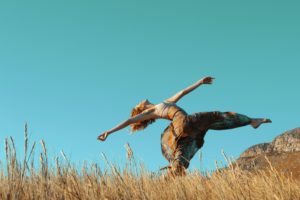Lido Wellness Center Blog
Gentle Movement for Stress Relief
April 20, 2022 | by Amy VanBeccelaere, LCPC, R-DMTApril is National Move More Month and Stress Awareness Month. Amy VanBeccelaere, is a dance/movement therapist and counselor at Lido Wellness Center. She shares her experiences of working with patients and alumni through movement in non-traditional ways.
Often when we hear, you need to move more, we immediately start to think about exercise. You might imagine yourself in the gym, sweating and forcing yourself to get active. Some people love going to the gym, and if this is you, by all means do it! Movement is meant to be joyful. Our bodies were created to move. Early people used movement to communicate, to celebrate, to grieve and to pray. Movement is innate. I believe that if you can tap into what type of movement lights you up inside, this is the movement that will not only feel good in your body but also in your soul. When you find this type of movement for stress relief, you don’t have to force anything. 
Practicing Movement for Stress Relief
In my private practice, I often move with clients. I think back to last week. I have a client who is going through a particularly hard time right now. So challenging that it is often difficult for him to find words to express it. He was feeling overwhelmed going into session and I suggested that we meet at a nearby nature preserve to hike. As he began to tell me what was going on in his life, I noticed that he began to become overwhelmed and dysregulated. At times, we would just stop among the wildflowers and birds, I would ask him to look around, orient and take a deep breath. He shared with me “I don’t think I have been breathing all week.”
As we continued to hike through the preserve together, he found that the movement itself and the breath work was helping more than the talking. So instead of forcing verbal processing, we shared presence in nature, breathing, noticing and moving. Together we saw eagles, butterflies, lizards, hummingbirds and gophers. We took long moments to inhale the scent of the wildflowers, the sage and the rosemary growing wild throughout the preserve. We felt the breeze on our cheeks as the wind blew. It was mindfulness practice. It was movement. My client expressed “This is exactly what I needed.” That same patient has returned to the nature reserve for movement on his own, twice, since that session.
April: Move More Month
So, as we ease into April: Move More Month, might I suggest that you get into nature? There are so many beautiful things blooming in the Spring. You might even find yourself with a new hobby or movement practice by doing so. It doesn’t have to be complicated. You can walk on a trail. Or you can ride your bike. You can take a hike. If you aren’t sure where to go, I would recommend googling local nature preserves.
Also, there is a great app called ‘All Trails’ that shows you local hikes and how long they are. This way you can choose something that you know will be approachable. A few weeks ago, I used this very same app to find a hike to a waterfall in Alaska. The hike was only 1.5 miles, so I knew it would be doable with my knee injuries. Movement is meant to add to your life, not be something laborious that you force yourself into. I hope you find movement that fills your soul. Nature is healing and immersive. So go ahead, take a walk on the wild side, you might find that it is just what you need.
Stress Relief in Newport Beach Mental Health Center
At Lido Wellness Center, mental health treatment in Orange County, CA, we integrate movement as part of the therapeutic journey for patients. As a premier wellness center, our aim is helping adults who are struggling with anxiety, depression, trauma, chronic pain and stressor-related conditions. Our expert clinical team is passionate about the care they provide. For information, please contact our team for a consultation at 949-541-8466.
by Amy VanBeccelaere, LCPC, R-DMT
Alumni and Patient Care Coordinator


